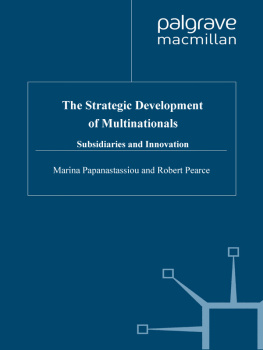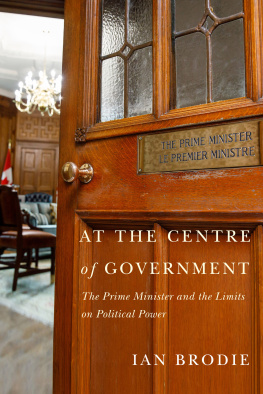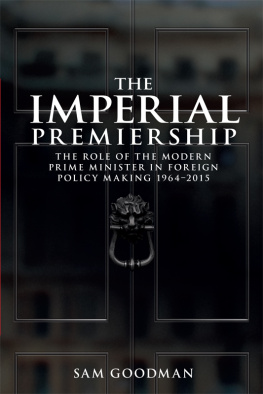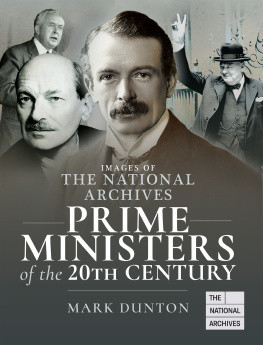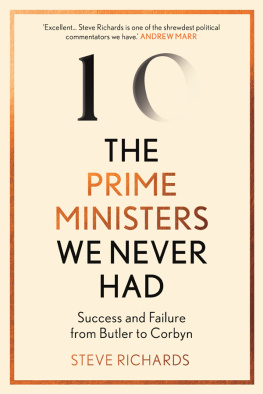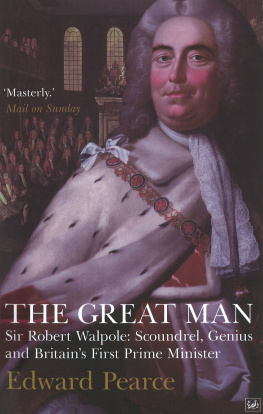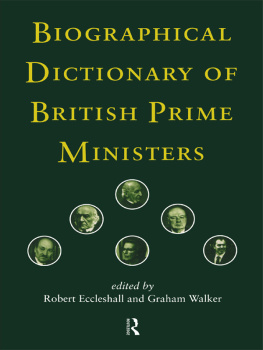British Prime Ministers from Balfour to Brown
The origins of the post of Prime Minister can be traced back to the eighteenth century when Sir Robert Walpole became the monarchs principal minister. From the dawn of the twentieth century to the early years of the twenty-first, however, both the power and the significance of the role have been transformed.
British Prime Ministers from Balfour to Brown explores the personalities and achievements of those 20 individuals who have held the highest political office between 1902 and 2010. It includes studies of the dominant premiers who helped shape Britain in peace and war Lloyd George, Churchill, Thatcher and Blair as well as portraits of the less familiar, from Asquith and Baldwin to Wilson and Heath. Each chapter gives a concise account of its subjects rise to power, ideas and motivations, and governing style, as well as examining his or her contribution to policy-making and handling of the major issues of the time. Robert Pearce and Graham Goodlad explore each Prime Ministers interaction with colleagues and political parties, as well as with Cabinet, Parliament and other key institutions of government. Furthermore they assess the significance, and current reputation, of each of the premiers.
This book charts both the evolving importance of the office of Prime Minister and the continuing restraints on the exercise of power by Britains leaders. These concise, accessible and stimulating biographies provide an essential resource for students of political history and general readers alike.
Robert Pearce, formerly Professor of Modern History at the University of Cumbria, is the author of many books on British and European history. The editor of History Review from 1998 to 2012, he is the General Editor of Routledge Historical Biographies.
Graham Goodlad is Director of Studies at St Johns College, Southsea. He has written widely on nineteenth- and twentieth-century British political history, most recently an essay in the collection Gladstone and Ireland (2010), edited by D.G. Boyce and Alan ODay.
First published 2013
by Routledge
2 Park Square, Milton Park, Abingdon, Oxon OX14 4RN
Simultaneously published in the USA and Canada
by Routledge
711 Third Avenue, New York, NY 10017
Routledge is an imprint of the Taylor & Francis Group, an informa business
2013 Robert Pearce and Graham Goodlad
The right of Robert Pearce and Graham Goodlad to be identified as authors of this work has been asserted by them in accordance with sections 77 and 78 of the Copyright, Designs and Patents Act 1988.
All rights reserved. No part of this book may be reprinted or reproduced or utilised in any form or by any electronic, mechanical, or other means, now known or hereafter invented, including photocopying and recording, or in any information storage or retrieval system, without permission in writing from the publishers.
Trademark notice: Product or corporate names may be trademarks or registered trademarks, and are used only for identification and explanation without intent to infringe.
British Library Cataloguing in Publication Data
A catalogue record for this book is available from the British Library
Library of Congress Cataloging in Publication Data
Pearce, R. D. (Robert D.)
British prime ministers from Balfour to Brown / Robert Pearce and Graham Goodlad.
pages cm
Includes bibliographical references and index.
1. Prime ministersGreat BritainBiography. 2. Prime ministersGreat BritainHistory20th centuryBiography. 3. Great BritainPolitics and government20th centuryBiography. 4. PoliticiansGreat BritainBiography. I.
Goodlad, Graham D. (Graham David), 1964 II. Title.
| DA566.9.A1P436 2013 |
| 9410820922dc23 | 2012047792 |
ISBN: 978-0-415-66982-5 (hbk)
ISBN: 978-0-415-66983-2 (pbk)
ISBN: 978-0-203-59369-1 (ebk)
The office of Prime Minister is what its holder chooses and is able to make of it.1
Herbert Henry Asquith (Prime Minister 190816), writing in 1926.
The British Prime Minister occupies one of the best known but also least well understood positions in public life. One of the difficulties is that the role has never had clear legal definition. The office is generally held to date back to Sir Robert Walpole (172142), who was recognized as the monarchs principal minister, responsible for managing both Parliament and the Cabinet, the group of senior ministers who collectively formed the supreme decision-making body in government. With a few exceptions, the Prime Minister sometimes known as the premier has simultaneously held the official title of First Lord of the Treasury. The term Prime Minister did not appear in a state document until the Treaty of Berlin in 1878 and the first office-holder to be granted a formal place in the order of precedence at the royal court was Sir Henry Campbell-Bannerman in December 1905. The first reference to the office in an Act of Parliament was in the 1917 Chequers Estate Act, which allocated Chequers, a country house in Buckinghamshire, to the Prime Minister as an official residence in addition to the better known address of Number 10, Downing Street.
If legal definition was slow to come, the political reality of the office was recognized much earlier. W.E. Gladstone, who served as Prime Minister four times in the Victorian era, wrote in 1878 that nowhere in the wide world does so great a substance cast so small a shadow; nowhere is there a man who has so much power, with so little to show for it in the way of formal title or prerogative.2 By the beginning of the twentieth century the main responsibilities of the office were well established: the management of the government as a whole, a task usually combined with the leadership of the largest party in Parliament; the power to determine the overall form and structure of the government, and to appoint its members; and a prominent role in the making of policy, especially in economic and foreign affairs. A responsibility which gained in importance as a result of the two world wars was the representation of the country in the international arena.
There is a great deal of truth in the quotation from H.H. Asquith with which this chapter begins. The nature of each premiership has been shaped to a great extent by the personality and aims of the individual office-holder; but all Prime Ministers also operate within a wider context which they themselves have not created. The flexibility of the role has sometimes been a source of strength, enabling successive office-holders to accrue new powers. Gladstone, for example, established in 1870 that only the Prime Minister had the right to call Cabinet meetings. In the special circumstances of December 1918, when Lloyd George sought King George Vs permission for the first postwar general election, another important power passed from the Cabinet as a whole to the premier alone: the right to ask the monarch to dissolve Parliament. Other powers, for example the Prime Ministers right to dismiss ministers, were clarified over time. Late nineteenth-century premiers generally believed that if a minister had proved politically or personally unacceptable, they should wait until the next general election, and then refuse to reappoint the individual in question. This was the fate of two ministers in Lord Salisburys government, for example, Sir Matthew White Ridley and Henry Chaplin, after the autumn 1900 khaki election. An important step forward was taken in September 1903 when Arthur Balfour removed three Cabinet opponents of changes to the free trade system. Even then, however, the actual method employed was to provoke their resignations rather than to dismiss them outright. It seems that it was the demands of running governments in wartime after 1914 that enabled premiers simply to sack a colleague outright.


